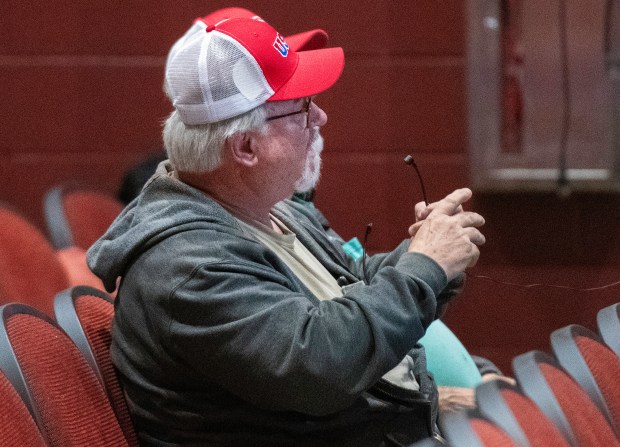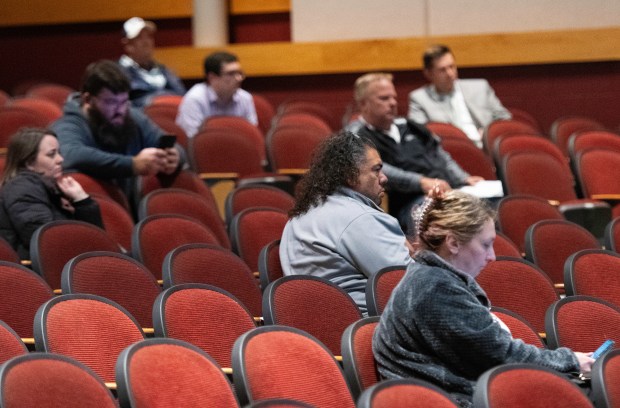The Citizens Action Coalition is enlisting the public in its fight against NIPSCO’s proposed 20% increase in electric rates.
“This is a shocking increase,” CAC Program Director Ben Inskeep said. “This increase is not fair, it’s not reasonable, it’s way outside the bounds of what regular folks are making.”
The Indiana Utility Regulatory Commission will hold a field hearing at 6 p.m. Tuesday at Ivy Tech Community College in Valparaiso.
The IURC is required to hold a second field hearing in Lake County, CAC Executive Director Kerwin Olson said, but it hasn’t been scheduled yet. Olson and his staff met with about 30 people Monday in Hebron High School’s auditorium to discuss NIPSCO’s request and prepare citizens to give effective testimony before the IURC.
Jeff Brooks, superintendent of MSD of Boone Township, invited the CAC to offer Monday’s program. “It impacts schools just as hard as it does citizens,” he said.
Schools, municipalities, large commercial customers and industrial users all have teams of lawyers working on their behalf, Inskeep said. The CAC works on behalf of residential users.
“NIPSCO has quite a few lawyers and a big legal team,” CAC Director of Development Kelly Hamman said. “We do our darnedest to go toe-to-toe with NIPSCO so you have a voice as well.”
“They file hundreds and hundreds of pages of testimony, spreadsheets that are huge and incredibly complex,” Hamman said. Inskeep wades through it all to make sense of it.
Olson said what the IURC needs to hear is how users would be affected by the proposed increase. A dad with a young child told how his electric bill increased 48.9% between November 2002 and November 2024 and wondered how pay raises compare to the increased cost of electricity over those years.
“That’s exactly the type of evidence we try to collect, analyze and present to the commission,” Inskeep said.
In another rate case in Evansville, a teacher testified that if that utility’s rate increase request were granted, it would wipe away her raise.
In South Bend, a senior citizen on Social Security detailed her actual monthly expenses and said she had $12 left. The utility wanted another $19 from her. Olson remembers her powerful testimony.

Jeff Grogan, of Hebron, said President-elect Donald Trump promised during his campaign to halve utility bills. “I’m going to hold him to that,” Grogan said.
“Can the federal government step in to help with what we’re talking about here tonight,” Grogan asked.
“The federal government has very little power when it comes to retail electric service,” Olson responded. “The feds play a marginal role when it comes to regulating your electric bill.”
“Everyone that takes a check, they work for us,” Grogan said. “America has forgotten that.”
The CAC website shows an “extraordinary amount of money” that utilities pay to legislators’ campaigns, Olson said.
“Do not forget the complicity of the Statehouse,” Olson said. “The IURC will frequently go out of their way to say we are a creature of statute.”
When utilities don’t get what they want from the IURC, they will go to the Indiana General Assembly and often get what the IURC denied them.

The Legislature not only killed the net metering program that encouraged individual use of solar panels but also prohibited net metering even if a utility wanted to offer it in the future, Olson noted.
Another audience member asked about the CAC’s success rate in fighting rate increase requests. It varies from case to case, Olson said. Frequently there are settlements.
“Settlement provides an opportunity to have some negations,” Olson said, but NIPSCO, Duke Energy and CenterPoint have all filed huge rate increase cases. “It’s hard to find middle ground when a utility wants $45 a month.”
Among the CAC successes reflected in this case is NIPSCO’s proposal to create special assistance for low-income residents and a smaller increase for multifamily residential units that put less demand on the grid. Those CAC requests were denied in an earlier NIPSCO rate increase request but included this time.
If approved, NIPSCO’s rates would go up in September 2025 and March 2026, increasing its revenue from $1.8 billion annually to nearly $2.2 billion.
“These guys earn more than a dime (in profit) for every dollar you send them. That’s simply outrageous,” Olson said.
“This is not a typical rate increase. $45 a month is extraordinary,” Inskeep said. NIPSCO says it’s a $32 monthly increase, but the CAC tacks on the $10 monthly increase forecast by NIPSCO to its bill trackers, or surcharges, plus the state sales tax to come up with the $45 figure.
“We’re going to fight this case. We’re going to fight it hard,” he said.
Utilities want to see nobody in the audience. “They want you to give up, stay home, not tell your friends and neighbors,” Inskeep said. “We are getting this issue elevated. We need to get people behind us.”
In addition to next week’s field hearing, the public can offer comments through Dec. 12 at www.in.gov/oucc/2361.htm or by mail at Public Comments, Indiana Office of Utility Consumer Counselor, 115 W. Washington St. Suite 1500 South, Indianapolis, IN 46204. Don’t include sensitive or personal information because the comments will be public online. Refer to either IURC Cause No. 46120 or NIPSCO Electric Rates. Include your name, city and ZIP code.
Since 1974, CAC has helped to save Hoosiers billions in excess utility charges, Hamman said. “We are stronger when we all stand together.”
Doug Ross is a freelance reporter for the Post-Tribune.




